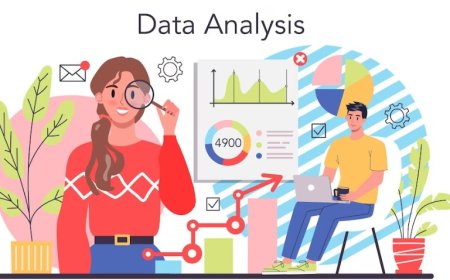Exploring the Role of Data Analytics in E-Commerce Optimization
Discover how data analytics drives e-commerce success. Explore key strategies, tools, and case studies to optimize your online business with data-driven insights.

The introduction provides a foundation for exploring the role of data analytics in e-commerce optimization. It begins by defining data analytics in the context of e-commerce, emphasizing its significance in leveraging data-driven insights for business growth. The section highlights the crucial importance of e-commerce optimization, underscoring how data analytics plays a pivotal role in enhancing various aspects of online businesses, from customer experience to operational efficiency. This sets the stage for a comprehensive examination of the tools, benefits, challenges, and future trends in data analytics within the e-commerce landscape.
Importance of E-Commerce Optimization
-
Understand customer behavior, preferences, and buying patterns.
-
Tailor product recommendations and marketing efforts for individual customers.
-
Optimize stock levels and reduce overstock/understock situations.
-
Set dynamic pricing based on demand, competition, and customer data.
-
Identify and prevent fraudulent transactions in real-time.
-
Experiment with website changes and marketing campaigns for data-driven improvements.
-
Analyze user journeys to enhance website design and user experience.
-
Forecast demand, sales trends, and customer churn for proactive decision-making.
-
Streamline operations, minimize wastage, and optimize supply chain logistics.
-
Stay ahead by leveraging data for strategic decision-making in a competitive market.
Data Analytics in E-Commerce
Data analytics plays a pivotal role in optimizing e-commerce operations. There are three primary types of data analytics employed in this context:
Types of Data Analytics
-
Descriptive Analytics: This type focuses on summarizing historical data to provide insights into past performance. E-commerce businesses use descriptive analytics to understand key metrics like website traffic, conversion rates, and customer demographics, helping them identify trends and patterns.
-
Predictive Analytics: Predictive analytics leverages historical data to forecast future trends and outcomes. E-commerce companies use predictive analytics to anticipate customer behavior, demand patterns, and inventory needs. It aids in proactive decision-making and resource allocation.
-
Prescriptive Analytics: Prescriptive analytics takes predictive insights a step further by recommending specific actions. In e-commerce, this helps in optimizing pricing strategies, marketing campaigns, and product recommendations, ultimately enhancing overall performance.
Key Data Sources
-
Website Traffic: Website analytics tools like Google Analytics provide valuable data on user interactions, page views, bounce rates, and more. Understanding how visitors engage with the website helps in optimizing its design and content.
-
Customer Behavior: Analyzing customer behavior involves tracking actions such as product views, cart additions, and purchase history. This data aids in creating personalized shopping experiences and improving product recommendations.
-
Sales Data: Sales data encompasses information on transactions, order values, and product performance. It is crucial for inventory management, pricing strategies, and revenue forecasting in e-commerce businesses.
These types of analytics and data sources form the foundation for e-commerce optimization, enabling businesses to make data-driven decisions and enhance their competitiveness in the digital marketplace.
The Benefits of Data Analytics in E-Commerce
Data analytics plays a pivotal role in enhancing the e-commerce landscape by offering a multitude of advantages. Firstly, it leads to an improved customer experience. Through the analysis of customer behavior, preferences, and purchase history, e-commerce businesses can tailor their offerings and user interfaces, resulting in more satisfying and engaging shopping experiences.
Secondly, data analytics enables personalization and recommendations. By leveraging machine learning algorithms, e-commerce platforms can suggest products to customers based on their browsing and buying patterns, increasing the likelihood of conversions and upsells.
Furthermore, data analytics aids in efficient inventory management. It helps businesses track stock levels, forecast demand, and optimize supply chain operations, reducing the risk of overstocking or stockouts and improving cost efficiency.
Additionally, pricing optimization is another significant benefit. E-commerce companies can dynamically adjust prices based on real-time market conditions and competitor pricing, maximizing revenue and competitiveness.
Lastly, data analytics is instrumental in fraud detection. It identifies unusual patterns in transactions and user behavior, allowing e-commerce businesses to promptly detect and prevent fraudulent activities, safeguarding both the company and its customers.
In summary, data analytics in e-commerce contributes to customer satisfaction, personalization, inventory efficiency, pricing optimization, and fraud prevention, making it an indispensable tool for success in the digital marketplace.
Data Analytics Tools and Technologies
Introduction to Analytics Tools:
Data analytics in E-commerce relies on a range of tools and platforms, with Google Analytics and Adobe Analytics being among the most popular. These tools provide insights into website traffic, customer behavior, and sales data. They help businesses track key performance indicators (KPIs), understand user journeys, and optimize website design and content for improved user experience.
Machine Learning and AI in E-Commerce:
Machine learning and artificial intelligence play a pivotal role in E-commerce optimization. These technologies enable predictive analytics for demand forecasting, product recommendations, and customer segmentation. Algorithms can analyze large datasets to identify patterns, allowing businesses to personalize marketing strategies and enhance product suggestions, ultimately driving sales and customer satisfaction.
Data Security and Privacy Considerations:
With the increasing reliance on data analytics, safeguarding customer information is paramount. E-commerce companies must adhere to strict data security and privacy regulations, such as GDPR and CCPA, to protect customer data. Implementing encryption, access controls, and regular security audits is essential to ensure data privacy and maintain customer trust. Additionally, ethical data usage practices should be a priority, balancing business goals with responsible data handling.
Challenges and Limitations
Data Analytics in E-Commerce faces several challenges and limitations that need careful consideration:
- Data Quality and Integration: One significant challenge is ensuring the quality and reliability of the data being analyzed. Inaccurate or incomplete data can lead to flawed insights and decision-making. Additionally, integrating data from various sources, such as CRM systems, social media, and transaction records, can be complex and time-consuming.
- Resource Constraints: Many E-Commerce businesses, especially small and medium-sized enterprises, may struggle with limited resources, both in terms of technology and skilled personnel. Investing in the necessary infrastructure and talent can be costly, making it a barrier to effective data analytics implementation.
- Ethical Concerns: As data analytics becomes more pervasive, ethical concerns regarding customer privacy and data usage have come to the forefront. E-Commerce businesses must navigate the delicate balance between leveraging customer data for optimization and respecting privacy regulations to avoid legal and reputational risks.
Addressing these challenges is crucial for maximizing the benefits of data analytics in E-Commerce while ensuring responsible and ethical practices.
Future Trends in Data Analytics for E-Commerce
As technology continues to evolve, the future of data analytics in e-commerce holds exciting possibilities. Here are some anticipated trends:
E-commerce businesses will increasingly harness the power of big data by integrating information from Internet of Things (IoT) devices. This will enable them to gather real-time data on product usage, customer preferences, and supply chain logistics, leading to more informed decisions.
Voice-activated commerce and chatbots are gaining traction. These technologies will become more sophisticated, providing seamless and personalized shopping experiences, driven by advanced natural language processing and machine learning algorithms.
E-commerce platforms will focus on hyper-personalization, tailoring product recommendations and content based not only on past behavior but also on real-time context. Artificial intelligence will play a pivotal role in delivering highly customized shopping journeys.
These trends promise to reshape the landscape of e-commerce, making it more data-driven, customer-centric, and efficient. Businesses that adapt and invest in these emerging trends will likely gain a competitive edge in the evolving e-commerce landscape.
Data analytics plays a pivotal role in E-Commerce, offering insights that drive profitability and enhance customer experiences. Its significance is undeniable, and its potential for future growth and innovation is promising. As businesses continue to navigate the digital landscape, the call to action for E-Commerce enterprises is clear: embrace data analytics as an indispensable tool for optimizing operations, staying competitive, and meeting evolving customer expectations in the dynamic world of online retail.




























































